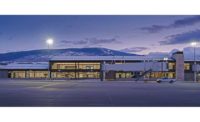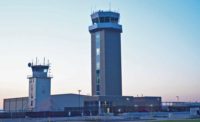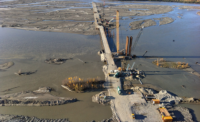Yeager Airport Runway 5 Safety Area
Charleston, W.Va.
Best Project and Excellence in Safety, Award of Merit
Owner: Central West Virginia Regional Airport Authority
General Contractor: Orders Construction
Lead Designer/Structural Engineer: Schnabel Engineering
Civil Engineers: ADCI; S&S Engineering
MEP Engineer: Burns Engineering
Five years ago, the catastrophic collapse of the structure supporting Runway 5’s emergency overrun area left a 140-ft vertical gash of partially reinforced fill looming over a 540,000-cu-yd debris field. It also obliterated an adjacent road. To restore the runway’s safety area as quickly as possible, the project team developed a strategy to clear more than a half-million cu yd of debris, stabilize the remaining slope and build a new two-part retaining wall.
Because deconstruction of the cliff did not conform with any acceptable slope-stability methods, the project team implemented an innovative risk reduction process that minimized the risk of further deterioration. To ensure worker safety within the unstable debris field, the contractor instituted a mandatory sign-in/sign-out process and buddy system for entering high-risk areas. Real-time monitoring instrumentation provided immediate notification to operators and foremen in the event any debris shifting was detected.
Built upward from the bottom, the new rock-anchored retaining wall was constructed in two phases so construction equipment would not interfere with airport operations. The wall system was designed with soldier piles and concrete lagging facing panels atop a drilled-shaft foundation. Its lower slope is backfilled with local soil materials. Upper sections use GeoFoam blocks to limit lateral earth pressures and vertical loading. Staging GeoFoam in nearby hangars and shuttling deliveries across the runway between flights eliminated the risk of damage and debris.
Despite the many potential distractions of the project’s aviation setting, the team kept close watch on the wall system’s alignment throughout construction. Defective concrete panels and other products that fell short of quality workmanship were immediately identified and replaced to prevent schedule disruptions. Deconstructed material intended for reuse as new backfill likewise underwent close scrutiny. An onsite processing operation removed oversized and substandard elements to yield material suitable for reuse as backfill.
As the new retaining wall worked its way upward, fall protection measures such as harnesses and handrails became especially important given the limited amount of space on the working bench. Carefully choreographed movements of large machinery, heavy wall components and support vehicles ensured that the project and the airport operated efficiently and safely. The team also had to be alert for jet blasts from departing aircraft.
Completed over nearly four years, the $15-million project faced extended periods of rain that also affected backfill processing. That resulted in schedule delays that increased total project costs by less than 7% of the initial estimate.
“This team obviously came together as a group, from owner all the way down to the subcontractors, knocking it out of the park,” a judge says. “The story spoke to me with the challenges they went through, basically being on the side of the cliff.”








Post a comment to this article
Report Abusive Comment